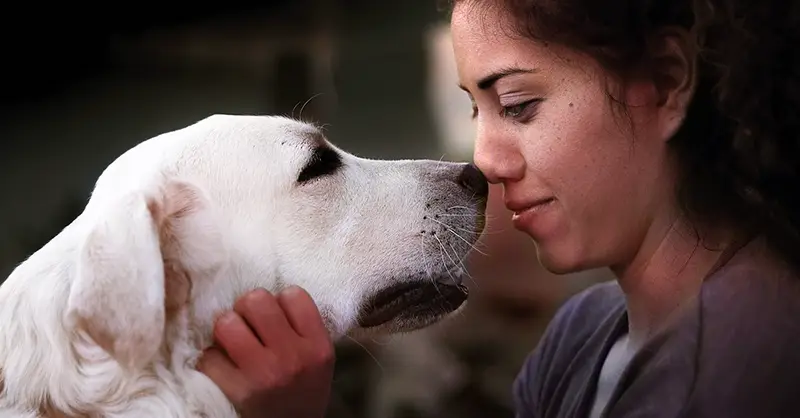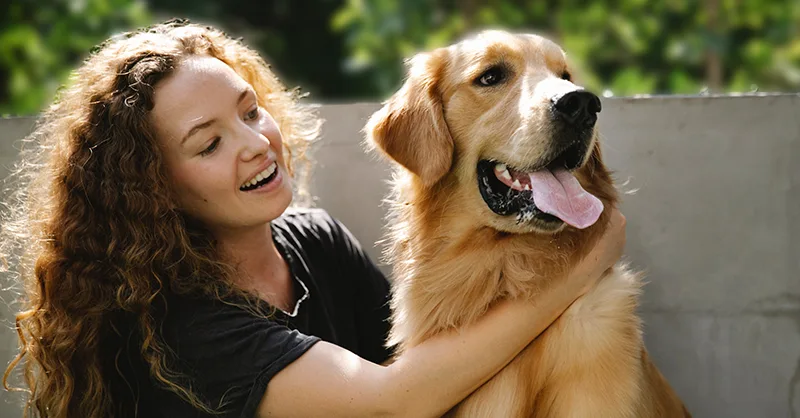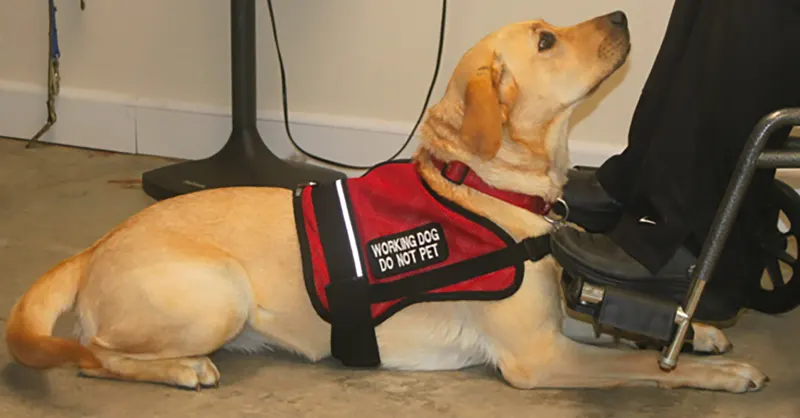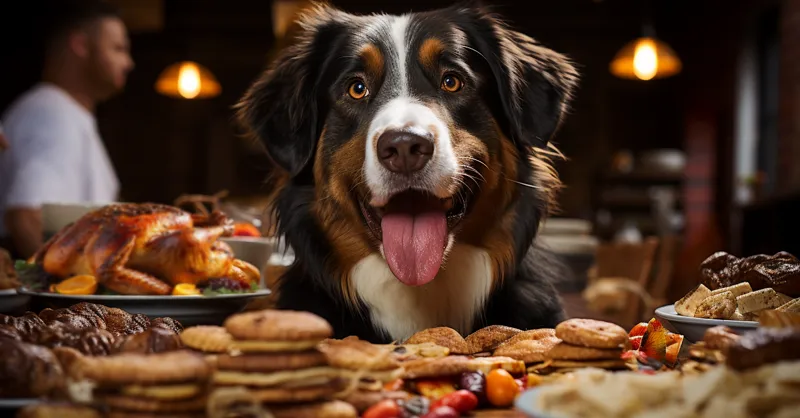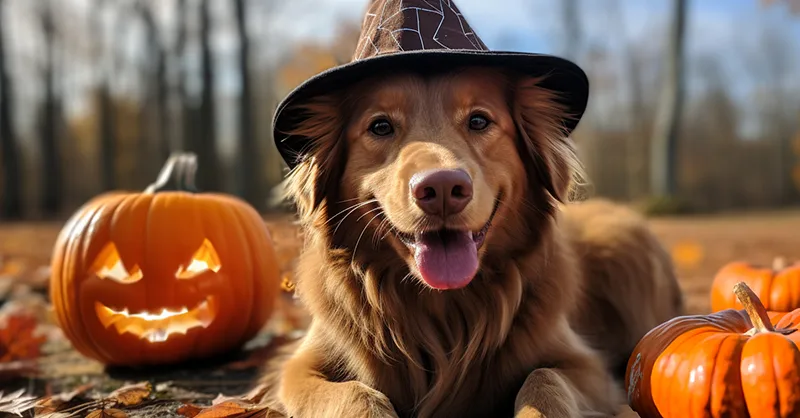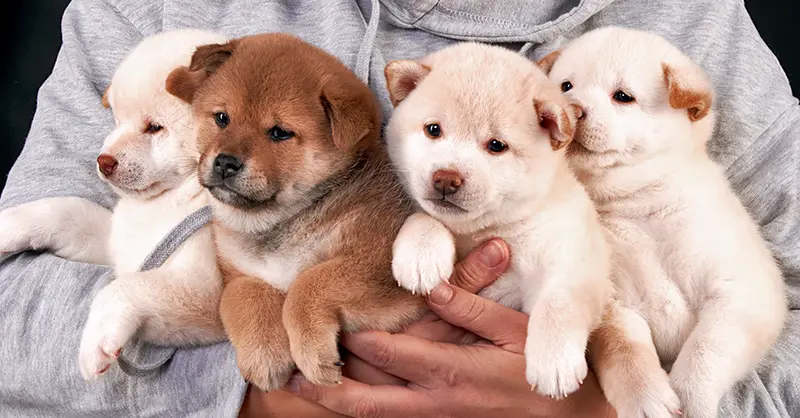Archive for the ‘Dogs’ Category
Thanksgiving is a time for family and friends to get together, share a meal, and reflect on what they’re thankful for – and many families have furry family members joining the festivities!
While it can be fun and exciting to have your dog join in on the fun, it is also important to stay vigilant when it comes to this holiday. While Thanksgiving is a joyous occasion for us, it can present several hazards to our canine companions.
In this guide, we’ll explore the best parts of having your pets join in on the fun, and some essential dog safety tips to ensure that you and your pets have a wonderful and incident-free holiday.
Pet Safe Thanksgiving FoodsWhile you always hear about the no-go Thanksgiving food you want to avoid giving your dog, there are actually several pet-safe treats you can set aside to let your pup enjoy!
In general, it’s always best to stick to a dog’s diet without having them over-indulge in new foods that they’re not used to. But there are a few safe Thanksgiving foods dogs can enjoy in moderation.
Remember, moderation is key! These foods should only be occasional treats, not a significant part of their diet. Always consult your vet if you’re unsure what’s safe for your pup to enjoy and if your dog would react well to it.
Cooked Turkey. Small amounts of plain, well-cooked turkey WITHOUT seasoning can be a great source of protein for your pup! Sweet Potatoes. Plain, cooked sweet potatoes are a healthy treat for a dog. Avoid adding any butter, spices, or other seasonings! Plain Pumpkin. Canned, plain pumpkin (not pumpkin pie filling) can be a healthy addition to any dog’s diet. Green Beans. Plain, steamed, or boiled green beans are a low-calorie, healthy option for dogs. They’re a good source of vitamins and fiber. Cranberries. A small amount of plain cranberries can be okay for dogs. Fresh or unsweetened dried cranberries are better. However, some dogs might find them too tart, so use them sparingly. Carrots. Fresh, raw, or cooked carrots can make for a crunchy and healthy treat. Apples. Fresh, sliced apples (without seeds) are a great source of vitamins and fiber. They can be a tasty and healthy treat. Rice. Plain, cooked white rice can be beneficial if your dog has an upset stomach.Always exercise caution and restraint when offering these foods to your dog. Ensure that they are plain and free from any seasonings, sauces, butter, or added ingredients that could be harmful.
Additionally, consider your dog’s individual dietary needs and any specific allergies or sensitivities they may have. If you’re uncertain about a particular food’s safety for your dog, consult with your veterinarian before offering it!
Share this image on your site (copy code below): <div style="clear:both"><a href="https://www.servicedogcertifications.org/thanksgiving-dog-safety/" target="_blank"><img decoding="async" style="max-width:100%;margin:0 0 10px;" src="https://www.servicedogcertifications.org/wp-content/uploads/2023/11/Safety-Tips-for-Dogs-on-Thanksgiving-scaled.jpg" title="Safety Tips for Dogs on Thanksgiving" alt="Pet safe and toxic food and other Thanksgiving party tips" border="0" data-src="" /></a></div> Copy
The Hazards of ThanksgivingThanksgiving is a time of delicious indulgence and fun with your friends and family, but it’s crucial to be aware of the harmful aspects to dogs. To ensure your furry friend’s safety, stay on the lookout for the following potential dangers on Thanksgiving – or any other time for that matter.
Toxic FoodWhile it can be tempting to feed your dog your leftovers and table scraps, there are tons of toxins included in the typical Thanksgiving spreads. While some options may be a tasty treat for your dog, be sure to be watchful of these unsafe options:
Bones. Avoid giving your dog turkey bones, as they can easily splinter and pose a choking hazard or cause internal injuries. Onion and Garlic. These common ingredients in Thanksgiving food, like stuffing and other dishes, are toxic to dogs and can lead to anemia. Chocolate. The theobromine and caffeine in chocolate can be harmful, causing heart problems, seizures, and other issues in dogs. Grapes and raisins. Even a small amount of these can lead to kidney failure in dogs. Nuts. Almonds, walnuts, and pecans are common household nuts that can be harmful to pups. These can cause digestive problems and even pancreatitis in small amounts. Alcohol. This one seems like a given, but alcohol can be easy for dogs to get into when left unattended. Alcohol is very harmful to your dog when consumed. Xylitol. A common sugar substitute that you may see around during the holidays, and is commonly found in foods like sugar-free gum. Products with this ingredient can lead to severe drops in blood sugar, seizures, and liver failure in dogs. High-Fat Foods. Fatty, greasy foods like turkey skin or gravy can lead to pancreatitis, a painful and potentially life-threatening condition in dogs. Dairy Products. Some dogs are lactose intolerant, and dairy products like cheese, milk, or butter can cause digestive issues. Spicy Foods. Dishes containing spices like hot peppers can irritate a dog’s digestive system. Avoid feeding your dog spicy foods or anything that’s heavily seasoned. Desserts. Sugary desserts, especially those containing xylitol, chocolate, or alcohol, should not be given to dogs. They can lead to various health issues.In general, it’s best to stick to your dog’s regular diet and avoid sharing too much of your human food, especially if you are unsure if the food is safe or not. Always prioritize your dog’s health and safety when it comes to their diet, and consult with your veterinarian if you have any doubts or concerns about what’s safe for your specific dog.
GuestsWhile your dog might be a happy-go-lucky pup, having so much interaction with guests who come over can, at times, pose some risks. With many unfamiliar faces and a change of routine, staying prepared for anything to happen is key.
When dogs are put under stress and stimulation, they may be at risk of showing strange behaviors, like aggression, due to overstimulation. So, to keep everyone safe, ensuring your dog is comfortable with the guests and gets plenty of breaks can be crucial.
If your dog tends to get stressed when they are over-socialized, keeping them on a leash at all times while people are over can be a good preventative plan.
Front DoorsThanksgiving gatherings may include guests who are not familiar with your dog’s tendencies or weaknesses. Therefore, with so many guests coming in and out through the front door, the risk of someone leaving the front door cracked can be higher than usual.
If you have a dog who is known to bolt out the front door, consider leaving him on a leash while people are over, leaving him in a safe, confined space, or leaving signs and notes around the door reminding others to keep it closed. But remember, if young children are present at your get-together, they might not be able to follow instructions well!
Even if your pup isn’t much of a runner when it comes to the front door, it only takes one stressful situation to put your dog into flight mode. So always make sure to keep them safe and secure.
DecorationsThanksgiving decorations, such as candles, table centerpieces, and even decorative gourds, can pose a hazard to dogs. A curious pup might knock over candles, ingest decorations, or chew on items that could lead to choking or blockages.
Ways to Prepare Your Dog for Thanksgiving Assess Your Dog’s PersonalityNot all dogs enjoy large gatherings or noisy environments. Consider your dog’s temperament and whether they are comfortable around new people or in crowded spaces. Some dogs may prefer a quiet, safe place to relax. And that’s okay!
Keep Your Dog EntertainedBefore the festivities, take your dog for a long walk or engage them in a stimulating play session. A tired dog is less likely to get into mischief and more likely to relax during the celebration. Mental stimulation, such as puzzle toys filled with treats, can also keep your dog occupied and mentally engaged.
Additionally, devise a plan for your dog to get some individual time DURING the festivities, too! A quick 10-minute play session every few hours can go a long way in preventing boredom or anxiety.
Create a Comfortable SpaceIn the event that your pup needs a quiet place to decompress, ensure you have a designated space prepared and ready!
If your dog is crate trained, keep their crate in a quiet space where they can retreat when necessary and decompress. If your dog is not crate trained, a small room or bathroom could serve as a safe space for your dog! Consider playing some calm, relaxing music in their safe space. Music helps enhance the feeling of comfort and tranquility!
Secure the TrashAfter the feast, the trash can be a goldmine for curious dogs. Dispose of leftovers and packaging securely in a trash can with a tight-fitting lid. Bones, scraps, and discarded food containers can pose a significant risk to your dog, potentially leading to digestive issues or choking hazards. It’s always better to be safe than sorry!
Avoid Decorative HazardsThanksgiving can often involve decorative items. While decorations add to the ambiance, they can be dangerous for your dog. Candles can be knocked over, posing a fire risk. Potpourri and certain plants, like poinsettias, can be toxic if ingested. Keep these items out of your pet’s reach to ensure their safety.
ID Tags and MicrochipsWith the doors opening and closing frequently due to the guests, there’s a higher chance of your dog slipping out unnoticed. Ensure your dog has a collar with an updated ID tag containing your up-to-date contact information. Additionally, having your pet microchipped can significantly increase the chances of a safe return if they get lost.
Additional Tips for a Happy Thanksgiving With Your Dog Consider Professional HelpDog professionals can be your best friends during the stressful holiday seasons! Vet’s, trainers, behaviorists, dog walkers, and pet sitters can all provide relief and assistance to a dog experiencing stress or fear revolving around the festivities.
If your dog is highly anxious or fearful, consider consulting a professional dog trainer or behaviorist for advice and support. Additionally, if your holiday schedule is packed to the brim, consider hiring someone to take care of the exercise and stimulation your dog may need to stay comfortable!
Prepare for EmergenciesDespite all precautions, accidents can still happen. Familiarize yourself with the location and contact details of the nearest emergency veterinary clinic. Having this information readily available can be crucial in case of an unexpected mishap.
In ConclusionThanksgiving can be a wonderful time for both you and your pets. By following these Thanksgiving tips, you can ensure that your dog has a safe, worry-free holiday.
Imagine Halloween through the eyes of a curious dog: baffling sights, peculiar smells, and an array of sounds, from the joyful squeals of costumed children to the persistent ringing of doorbells. It’s a time of excitement and potential stress that warrants special attention from dog owners. Here, we explore how to make Halloween a joyful, stress-free occasion for our canine companions.
1: Neutralizing Noise Nuisances 2: Sifting through the Sweets 3: Decor Dilemmas 4: Costume Considerations 5: Behavioral Balancing 6: Preparing for Potential Perils Final ThoughtsShare this image on your site (copy code below): <div style="clear:both"><a href="https://www.servicedogcertifications.org/halloween-dog-safety/" target="_blank"><img decoding="async" style="max-width:100%;margin:0 0 10px;" src="https://www.servicedogcertifications.org/wp-content/uploads/2023/10/How-to-Keep-Your-Dog-Safe-on-Halloween.jpg" title="How to Keep Your Dog Safe on Halloween" alt="6 tips on how to keep your dog safe during Halloween celebrations" border="0" data-src="" /></a></div> Copy
1: Neutralizing Noise NuisancesCreate a tranquil retreat for your dog away from the front door’s hustle and bustle, particularly if you have a parade of trick-or-treaters visiting. Employing background white noise or calming dog music can mask the cacophony outside, providing a serene sanctuary for your pup.
2: Sifting through the SweetsSome Halloween treats can be toxic for dogs. Establish a safe zone for candies, ensuring they are stashed away from curious noses. Emphasize to children the importance of not sharing their sugary loot with their four-legged friend. Have dog-friendly treats on hand to satisfy their curious palate.
Be particularly mindful of the following Halloween treats:
Chocolaty Peril: The menace in chocolate arises from its theobromine content. Swift veterinary action is crucial following any ingestion. Candies & Gums: The specter of xylitol, a common artificial sweetener, pervades numerous candies, especially the sugar-free variants. Its presence not only in sweets but unexpectedly in items like toothpaste demands vigilant scrutiny of all accessible items. Raisin Risks: Often seen as a healthier option for trick-or-treaters, raisins can cause renal failure in dogs. Be mindful of treats that contain raisins as an ingredient. Hard Candy Hazards: Besides being a choking hazard, hard candies can conglomerate in a dog’s stomach, paving the way for potential obstructions. 3: Decor DilemmasChoose decorations wisely! Ensure they are not only safe from curious chomping but also won’t terrify your dog. Reflective, non-flashing lights and non-dangling decorations can preserve the festive spirit without alarming your pup.
The alluring luminescence of glow sticks may be irresistible to playful pups but harbors a danger if punctured and consumed. Also, be mindful of candles. The enthralling flicker of candles and battery-operated and wired decorations must be placed beyond the reach of wagging tails and inquisitive noses to forestall burns and avoid chew-related mishaps. Keep those jack-o’-lanterns away from your four-legged friend – they can present a major fire hazard.
Whatever your plans are for Halloween, make sure your dog is comfortable and enjoys the activities as much as you do. 4: Costume ConsiderationsIf you plan to dress up your dog, opt for minimal, non-restrictive costumes that don’t impair sight, sound, or movement. Forgo costumes with chewable or dangling elements. Prioritize their comfort and be ready to ditch the costume if it causes distress. Always prioritize their well-being over a cute photo-op.
5: Behavioral BalancingWhile some dogs may revel in the novelty of Halloween, others may find the influx of costumed visitors and altered environment unsettling. Assess your dog’s comfort levels and adapt accordingly, perhaps opting for a secluded sanctuary away from the ghostly goings-on.
6: Preparing for Potential PerilsEnsure your dog is securely indoors as night falls. Having a recent photo and ensuring their ID tags and microchips are up-to-date can act as a safety net in case of unexpected escapes.
Order Here Final ThoughtsNavigating Halloween with a canine companion can indeed be a delight if guided by considerate, dog-friendly practices. By mitigating potential stressors and safeguarding against perils, we pave the way for a howling good time for all members of the household. May your Halloween be filled with more treats than tricks for you and your furry friend!
Bringing a new furry companion into your life is a huge decision, and finding the right breeder can play a huge part when it comes to ensuring a healthy and happy companion.
In this article, we will walk you through the steps to find a responsible breeder, while also highlighting the importance of considering adoption as a compassionate alternative!
There are many breeders, but not all are ethical and reputable. Therefore, staying updated and educated on how to make the most informed decision for you and your family can go a long way!
Table of contents 1. Research the Breed 2. Seek Out Recommendations and Reviews 3. Visit Websites That Have Good Reputation 4. Interview the Breeder 5. Conduct In-Person Visits 6. Review Contracts Carefully 7. How to Tell a Puppy Mill from a Reputable Breeder 8. Consider Adoption 1. Research the BreedBefore taking the time and diving into finding a good breeder, research the breed you’re looking for.
Every breed is unique and has needs that require a certain lifestyle and ownership. Knowing what you are ready for and what type of temperament would fit into your family can set you up for success and help you understand your new pup on a deeper level!
It is essential to research and select the breed that matches your routine, physical lifestyle, preferences, and general capabilities.
Some aspects of your life that you may want to evaluate before you research your breed should be:
Lifestyle – How active are you? How much of your life do you plan on involving your dog in? Living Situation – Are you in an apartment or a house with a yard? With roommates or living alone? Is everyone in your family on board with adding a dog to your family? Budget – Would you be able to pay for a bigger dog’s food/vet budget? A dog can cost up to $1,825 in the first year alone! Time Commitment – Some breeds need much more of your daily attention than others, and knowing how much time you can commit each day to training and exercise plays a huge role. Allergies – Do you have any allergies that may be affected by a dog? Most allergies to dogs are not hair-related, but if dog hair bothers you, you may want to go with a breed that has minimal shedding.These questions should be evaluated thoroughly. Once you know the answers, it’s crucial to see if they match the breed you were looking at. If they don’t, consider further research into breeds that may be a better match!
2. Seek Out Recommendations and ReviewsReaching out to valued members of your communities (well-rated vets, trainers, and groomers) can go a long way! These professionals typically can steer you in the right direction of finding a good breeder and giving some additional insight into what dog breed may best match your situation. Creating relationships with these professionals can also be beneficial, so you know who you can trust once your new family member does come into your life!
Avoid recommendations from people you don’t know or professionals who lack experience in the dog community. There is so much information out there; choose your guidance wisely!
Most breeders have social media. Using their pages to find previous owners who have bought from them before can also be a good way to seek out recommendations.
3. Visit Websites That Have Good ReputationThere are tons of great resources out there that can help steer you in the right direction of knowing what breeders are out there. The American Kennel Club (AKC) and the United Kennel Club (UKC) are reputable organizations that list breeders on their website by breed and location.
Even though these organizations are reputable, it is important to note that the requirements for a breeder to be listed on these websites are not very strict, and these organizations do not contact in-person visits to ensure accuracy. It is advised to use websites like these as a resource to find the breeders who list their dogs as AKC and UKC certified, and conduct your own research from there!
Follow social media and other available sources to make sure the dog breeder has a good reputation. 4. Interview the BreederOnce you feel confident that you have found the right fit for a breeder, it’s time to get to know them!
Reach out with questions you want to ask them! These questions should gauge their ethics, policies, knowledge of the breed, etc.
Some good questions you may want to ask a potential dog breeder are:
How long have you been breeding this breed? What type of health testing do you conduct on your parent dogs? Are the puppies vaccinated and dewormed? Do you have any references or reviews from previous puppy owners? Can I visit and meet the parents and puppies? How do you socialize your puppies? Who comes in contact with them during the first 8 weeks?In addition to these basic questions, now is your time to ask anything else that might be on your mind. There are no silly questions when it comes to finding the right breeder, so ask away!
It may seem overkill to ask many questions, but any breeder annoyed or frustrated while answering may not be a good fit anyway! These are common questions that any reputable breeder would most likely be happy to answer – especially since it shows you are a serious and prepared future puppy parent!
During an interview with a breeder, it’s also crucial to trust your instincts! If anything they say or do leaves a bad taste in your mouth, it’s time to move on to the next!
It’s common for a good breeder to ask YOU a ton of questions as well to ensure that you would be a good fit for one of their pups! They will also typically never pressure you into buying a dog, as they might even have a waiting list for their puppies!
If you feel good about the breeder you spoke with, it’s time to move to the exciting part: meeting in person!
5. Conduct In-Person VisitsNow it’s time to meet the breeder in person! In some cases, the puppies may not be born yet, but if they are, it’s time to meet the puppies and parents, too.
Seeing the dogs’ living conditions and their routine through your own eyes can provide valuable insight into the breeders’ practices. Pay close attention to the dogs and puppies to make sure there are no red flags during your visit.
6. Review Contracts CarefullyOnce you feel ready to make your choice, it’s important to carefully review the documents and contracts that get sent your way!
Contracts from a good breeder should include:
Health and behavior guarantees – Of course, there is no way to know if a random behavior or health concern arises, but a good breeder would do everything in their power to breed healthy dogs, both mentally and physically. Spay/neuter requirements – Most breeders would require their dogs to be spayed and neutered to prevent unwanted pregnancies and to reduce irresponsible breeding. Thorough return policies – Ideally, their policy would be to return the dog to THEM in case you can no longer care for the dog, as they would typically have a list of people wanting to take the dog in these cases!If the contract seems too vague or doesn’t cover items to the ones above, investigate further. A breeder who is too casual about homing their dogs without the proper documentation might not be a breeder you want to stick with.
7. How to Tell a Puppy Mill from a Reputable BreederKnowing the difference between a puppy mill and a breeder might be one of the most important things to understand in finding the right breeder.
A puppy mill is a commercial facility that focuses on breeding as many dogs as possible for profit and is incredibly unregulated. The conditions of a puppy mill would be dirty, unethical, and unorganized. These factors can cause many issues with the puppies’ health and would have long-lasting effects on the dogs raised in a facility like this.
During your breeder search process, look out for red flags that indicate they may not care about the well-being of their dogs and puppies.
Some red flags that you might be dealing with a puppy mill are:
They won’t share information about the puppies or parents with you, or seem like they withhold information. They have many cages stacked on each other in their facility. They come up with excuses as to why you can’t meet the puppies’ parents (like “they are out of town,” or “resting in another room.”) They offer to send the puppy to you before they reach the mature weaning age (6-8 weeks) They offer to drive or fly the dog to you without meeting or interviewing you first. They don’t take too much interest in you, your living situations, or your lifestyle. They offer and sell a range of different breeds on their website or social media pages.If you find yourself in a situation where you suspect the breeder you’re speaking with may be a puppy mill, it’s time to move on and find someone else.
It is also important to note that there are several websites that scam people every day by trying to get money or down payments from you BEFORE you meet the dog. Therefore, it is crucial to follow the golden rule: Don’t pay for a puppy that you haven’t met yet!
Research the dog breeder well, and do not fall for scams or puppy mills. 8. Consider AdoptionWhile finding a good breeder is important, it is equally important to consider the compassionate alternative: adopting a dog who needs a home!
Whether you are looking for a young puppy or an adult dog, there are amazing rescues and shelters that can still pair you with your dream dog.
Not only do shelters and rescues tend to have an abundance of young, healthy puppies, but they also have tons of adult dogs! If you evaluate your lifestyle and what kind of dog would fit best into your home, you may find that an adult dog is a much better fit than a young puppy. Puppies can take a lot of patience, extra time, and work. This is where adopting an older and more established dog can have its benefits!
If you’re still looking around for your new family member, check out your local rescues and shelters pages for their available dogs and puppies! You might just fall in love!
If you still choose to go through a breeder to find your new dog, staying educated and prepared helps battle the problem of dog population. Puppy mills and unethical backyard breeding are huge contributors to dogs who end up in shelters in the first place. Additionally, knowing the type of dog that would fit your lifestyle can prevent the unfortunate reality of rehoming in the future.
While finding the right breeder can be a lengthy process, it will all be worth it when you bring home your new best friend!
